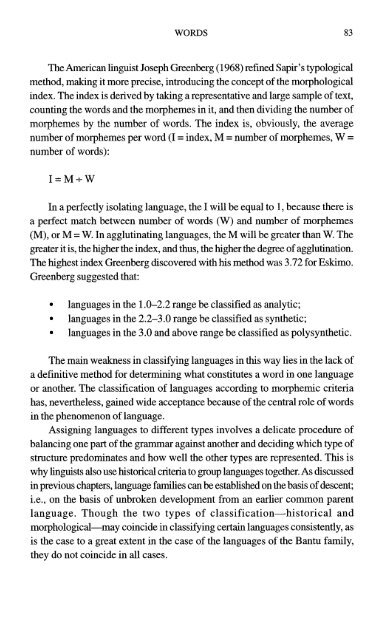A Basic Course in Anthropological Linguistics (Studies in Linguistic ...
A Basic Course in Anthropological Linguistics (Studies in Linguistic ...
A Basic Course in Anthropological Linguistics (Studies in Linguistic ...
Create successful ePaper yourself
Turn your PDF publications into a flip-book with our unique Google optimized e-Paper software.
WORDS 83<br />
The American l<strong>in</strong>guist Joseph Greenberg (1968) ref<strong>in</strong>ed Sapir 's typological<br />
method, mak<strong>in</strong>g it more precise, <strong>in</strong>troduc<strong>in</strong>g the concept of the morphological<br />
<strong>in</strong>dex. The <strong>in</strong>dex is derived by tak<strong>in</strong>g a representative and large sample of text,<br />
count<strong>in</strong>g the words and the morphemes <strong>in</strong> it, and then divid<strong>in</strong>g the number of<br />
morphemes by the number of words. The <strong>in</strong>dex is, obviously, the average<br />
number of morphemes per word (I = <strong>in</strong>dex, M = number of morphemes, W =<br />
number of words):<br />
In a perfectly isolat<strong>in</strong>g language, the I will be equal to 1, because there is<br />
a perfect match between number of words (W) and number of morphemes<br />
(M), or M = W. In agglut<strong>in</strong>at<strong>in</strong>g languages, the M will be greater than W. The<br />
greater it is, the higher the <strong>in</strong>dex, and thus, the higher the degree of agglut<strong>in</strong>ation.<br />
The highest <strong>in</strong>dex Greenberg discovered with his method was 3.72 for Eskimo.<br />
Greenberg suggested that:<br />
languages <strong>in</strong> the 1 .O-2.2 range be classified as analytic;<br />
languages <strong>in</strong> the 2.2-3.0 range be classified as synthetic;<br />
languages <strong>in</strong> the 3.0 and above range be classified as polysynthetic.<br />
The ma<strong>in</strong> weakness <strong>in</strong> classify<strong>in</strong>g languages <strong>in</strong> this way lies <strong>in</strong> the lack of<br />
a def<strong>in</strong>itive method for determ<strong>in</strong><strong>in</strong>g what constitutes a word <strong>in</strong> one language<br />
or another. The classification of languages accord<strong>in</strong>g to morphemic criteria<br />
has, nevertheless, ga<strong>in</strong>ed wide acceptance because of the central role of words<br />
<strong>in</strong> the phenomenon of language.<br />
Assign<strong>in</strong>g languages to different types <strong>in</strong>volves a delicate procedure of<br />
balanc<strong>in</strong>g one part of the grammar aga<strong>in</strong>st another and decid<strong>in</strong>g which type of<br />
structure predom<strong>in</strong>ates and how well the other types are represented. This is<br />
why l<strong>in</strong>guists also use historical criteria to group languages together. As discussed<br />
<strong>in</strong> previous chapters, language families can be established on the basis of descent;<br />
i.e., on the basis of unbroken development from an earlier common parent<br />
language. Though the two types of classification-historical and<br />
morphological-may co<strong>in</strong>cide <strong>in</strong> classify<strong>in</strong>g certa<strong>in</strong> languages consistently, as<br />
is the case to a great extent <strong>in</strong> the case of the languages of the Bantu family,<br />
they do not co<strong>in</strong>cide <strong>in</strong> all cases.






